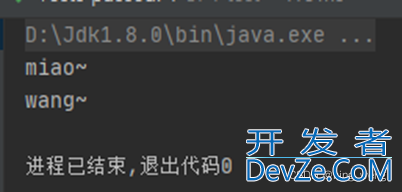Spring中byName和byType的区别及说明
目录
- 测试实例
- 一、在配置文件中装配bean
- (一)byName
- (二)byType
- 二、使用注解实现自动装配
- (一)@Autowired
- (二)Qualifier
- (三)@Resource
- @Autowired与@Resource异同
- 总结
测试实例
Cat类:
public class Cat {
public void sound(){
System.out.println("miao~");
}
}
Dog类:
public class Dog {
public void sound(){
System.out.println("wang~");
}
}
People类:
public class People {
private Cat cat;
private Dog dog;
private String nameandroid;
public Cat getCat(){
return cat;
}
public void setCat(Cat cat) {
www.devze.comthis.cat = cat;
}
public Dog getDog(){
return dog;
}
public void setDog(Dog dog) {
this.dog = dog;
}
public String getName() {
return name;
}
public void setName(String name) {
this.name = name;
}
}
XML配置文件:
<?xml version="1.0" encoding="UTF-8"?>
<beans xmlns="http://www.springframework.org/schema/beans"
xmlns:xsi="http://www.w3.org/2001/XMLSchema-instance"
xmlns:context="http://www.springframework.org/schema/context"
xsi:schemaLocation="http://www.springframework.org/schema/beans
http://www.springframework.org/schema/beans/spring-beans.xsd
http://www.springframework.org/schema/context
http://www.springframework.org/schema/context/spring-context.xsd">
<bean id = "cat" class="com.hello.pojo.Cat"/>
<bean id = "dog" class="com.hello.pojo.Dog"/>
<bean id = "people" class="com.hello.pojo.People">
<property name="cat" ref="cat"/>
<property name="dog" ref="dog"/>
<property name="name" value="wzh"/>
</bean>
</beans>
输出:

一、在配置文件中装配bean
(一)byName
byName就是通过Bean的属性名称(id或name)自动装配。
www.devze.com实例:
1、修改xml配置,增加一个属性 autowire="byName":
<bean id = "cat" class="com.hello.pojo.Cat"/>
<bean id = "dog" class="com.hello.pojo.Dog"/>
<bean id = "people" class="com.hello.pojo.People" autowire="byName">
<property name="name" value="wzh"/>
</bean>
此时测试成功
2、我们将 cat 的bean id修改为 catXXX
<bean id = "cat2" class="com.hello.pojo.Cat"/>
出现错误如下:

执行时报空指针Java.lang.NullPointerException。因为按byName规则找不对应set方法,真正的setCat就没执行,对象就没有初始化,所以调用时就会报空指针错误。
小结:
当一个bean节点带有 autowire byName的属性时。
(1)将查找其类中所有的set方法名,例如setCat,获得将set去掉并且首字母小写的字符串,即cat。
(2)去spring容器中寻找是否有此字符串名称id的对象。
(3)如果有,就取出注入;如果没有,就报空指针异常。
(二)byType
byName就是通过Bean的Class类型来自动装配。使用autowire byType首先需要保证:同一类型的对象,在spring容器中唯一。如果不唯一,会报不唯一的异常。
实例:
在xml配置再注册一个cat的bean对象:
<bean id = "cat" class="com.hello.pojo.Cat"/>
<bean id = "cat2" class="com.hello.pojo.Cat"/>
<bean id = "dog" class="com.hello.pojo.Dog"/>
<bean id = "people" class="com.hello.pojo.People" autowire="byType">
<!-- <property name="cat" ref="cat"/>-->
<!-- <property name="dog" ref="dog"/>-->
<property name="name" value="wzh"/>
</bean>
测试结果:
org.springframework.be开发者_Python入门ans.factory.UnsatisfiedDependencyException: Error creating bean with name 'people' defined in class path resource [beans.xml]: Unsatisfied dependency expressed through bean property 'cat'; nested exception is org.springframework.beans.factory.NoUniqueBeanDefinitionException: No qualifying bean of type 'com.hello.pojo.Cat' available: expected single matching bean but found 2: cat,cat2
“NoUniqueBeanDefinitionException”,即bean定义不唯一。删掉其中一个cat的bean对象,将cat的bean名称改掉,则可测试成功,因为是按类型装配,所以并不会报异常,也不影响最后的结果。甚至将id属性去掉,也不影响结果。
二、使用注解实现自动装配
0、使用注解实现自动装配需要在xml配置文件中添加以下2个支持:
(1)在spring配置文件中引入context文件头
xmlns:context="http://www.springframework.org/schema/context" http://www.springframework.org/schema/context http://www.springframework.org/schema/context/spring-context.xsd
(2)开启属性注解支持!
<context:annotation-config/>
(一)@Autowired
- @Autowired是按类型自动转配的,不支持id匹配。
- 需要导入 spring-aop的包!
1、测试
(1)将People类中的set方法去掉,使用@Autowired注解
public class People {
@Autowired
private Cat cat;
@Autowired
private Dog dog;
private String name;
public Cat getCat(){
return cat;
}
public Dog getDog(){
return dog;
}
public String getName() {
return name;
}
}
此时ml配置文件:
<context:annotation-config/>
<bean id = "cat" class="com.hello.pojo.Cat"/>
<bean id = "dog" class="com.hello.pojo.Dog"/>
<bean id = "people" class="com.hello.pojo.People">
</bean>
测试结果:

注:@Autowired(required=false) 说明对象可以为null;如果required=false,则对象必须存对象,不能为null。
(二)Qualifier
- @Autowired是根据类型自动装配的,加上@Qualifier则可以根据byName的方式自动装配。
- @Qualifier不能单独使用。
测试:
(1)配置文件修改内容,保证类型存在对象。且名字不为类的默认名字。
<bean id = "cat1" class="com.hello.pojo.Cat"/>
<bean id = "cat2" class="com.hello.pojo.Cat"/>
<bean id = "dog1" class="com.hello.pojo.Dog"/>
<bean id = "dog2" class="com.hello.pojo.Dog"/>
此时报错:
org.springframework.beans.factory.UnsatisfiedDependencyException: Error creating bean with name 'people': Unsatisfied dependency expressed through field 'cat'; 编程nested exception is org.springframework.beans.factory.NoUniqueBeanDefinitionException: No qualifying bean of type 'com.hello.pojo.Cat' available: expected single matching bean but found 2: cat1,cat2
(2)在属性上添加Qualifier注解
@Autowired
@Qualifier(value = "cat2")
private Cat cat;
@Autowired
@Qualifier(value = "dog2")
private Dog dog;
测试测试成功。
(三)@Resource
- @Resource如有指定的name属性,先按该属性进行byName方式查找装配;
- 其次再进行默认的byName方式进行装配;
- 如果以上都不成功,则按byType的方式自动装配。
- 都不成功,则报异常。
测试:
public class People {
@Resource(nandroidame = "cat2")
private Cat cat;
@Resource(name = "dog2")
private Dog dog;
private String name;
public Cat getCat(){
return cat;
}
public Dog getDog(){
return dog;
}
public String getName() {
return name;
}
}
此时xml配置文件:
<bean id = "cat1" class="com.hello.pojo.Cat"/>
<bean id = "cat2" class="com.hello.pojo.Cat"/>
<bean id = "dog1" class="com.hello.pojo.Dog"/>
<bean id = "dog2" class="com.hello.pojo.Dog"/>
(2)实体类和xml配置文件:
public class People {
@Resource
private Cat cat;
@Resource
private Dog dog;
private String name;
public Cat getCat(){
return cat;
}
public Dog getDog(){
return dog;
}
public String getName() {
return name;
}
}
配置文件:
<bean id = "cat1" class="com.hello.pojo.Cat"/>
<bean id = "dog1" class="com.hello.pojo.Dog"/>
测试结果成功输出。
结论:
@Resource先进行byName查找,失败;再进行byType查找,成功。
小结:
@Autowired与@Resource异同
- @Autowired与@Resource都可以用来装配bean。都可以写在字段上,或写在setter方法上。
- @Autowired默认按类型装配(属于spring规范),默认情况下必须要求依赖对象必须存在,如果要允许null 值,可以设置它的required属性为false,如:@Autowired(required=false) ,如果我们想使用名称装配可以结合@Qualifier注解进行使用
- @Resource(属于J2EE复返),默认按照名称进行装配,名称可以通过name属性进行指定。如果没有指定name属性,当注解写在字段上时,默认取字段名进行按照名称查找,如果注解写在setter方法上默认取属性名进行装配。当找不到与名称匹配的bean时才按照类型进行装配。但是需要注意的是,如果name属性一旦指定,就只会按照名称进行装配。
- 它们的作用相同都是用注解方式注入对象,但执行顺序不同。@Autowired先byType,@Resource先byName。
总结
以上为个人经验,希望能给大家一个参考,也希望大家多多支持我们。






 加载中,请稍侯......
加载中,请稍侯......
精彩评论